Introduction
A co-operative is an autonomous association of persons united voluntarily to meet their common economic, social, and cultural needs and aspirations through a jointly owned and democratically controlled enterprise (International Co-operatives Alliance, 1995). Ismail (2005) also stated that the co-operative’s identity is that the members, and the members themselves, determine the direction of the co-operative in improving their socio-economy. The co-operative movement in Malaysia began in 1922 and to date Malaysian government has launched the Dasar Keusahawanan Nasional (DKN) 2030 with the objective as a guideline to provide a holistic framework or ecosystem for entrepreneurial development in Malaysia. The co-operative sector is one of the drivers for social development in Malaysia whereby the government targets co-operatives to contribute 60 million turnovers by the year 2030.
School co-operatives, as one of the co-operative sectors in Malaysia, has accepted the government challenge to become one of the main contributors to Malaysia economy. This is supported by the statement from the National Co-operative Movement of Malaysia Bhd (Angkasa); Datuk Abdul Fatah Abdullah said that government needs to focus on the development of co-operatives, schools in this country as a platform to realize the desire to make Malaysia as an entrepreneurial nation by 2030, in line with DKN 2030 (Sinar harian, 2019). Othman, Embi, Aris, Arif, Choo & Ismail (2016) also concurred that co-operatives are anticipated to contribute to economic growth, develop into competitive business entities, and continue to be successful self-help groups while maintaining sensitivity to the environment. Therefore, to achieve the 60 million turnovers by the year 2030 as a targeted goal, all school co-operatives must ensure that their management and administration is in good condition (Shabri, Saad & Bakar, 2017). Therefore, a good strategy and good accountability need to be strengthened in school co-operatives in order to achieve the target.
The number of Malaysian school co-operatives continue to increasingly grow, with 2,460 school co-operatives established with a total turnover of RM206.70 million based on the Co-operatives Statistic Malaysia interim 2021. According to the Co-operative Societies Act (1993), students aged twelve (12) and above are eligible to become a member of a co-operative, where the school management would appoint students either as ordinary members, committee members or co-operative board members. Hence, the students themselves involve as members and contribute to the co-operative share at the age of thirteen years old (from one) and participate in the school co-operatives. They are now playing significant role not just to study but also must be able to manage the school co-operative as advised by the teacher and regulator.
Therefore, this study will explore the strategy and accountability level in school co-operatives by exploring the management process in school co-operatives from the perspectives of strategy and accountability, identifying the indicators of strategy and accountability in school co-operatives and developing a framework of strategy and accountability in school co-operatives. The following sections will discuss the literature review of the strategy and accountability in school co-operatives followed by methodology and findings
Literature Review
School Co-operatives
Back in 1968, Professor Diraja Ungku Aziz has initiated the establishment of nine pioneer school co-operatives in six Malaysian states (Juliana, 2016). She has illustrated the organization chart of school co-operatives which exhibit the involvement of students as a committee member and co-operative board member in the school co-operative. This demonstrates the significance of students’ involvement in the planning, management, and organization of school co-operatives with teachers. While Ewang, Abidin, & Rustam (2020) in their research emphasize the role of teachers as the co-operative managers, may influence the performance of school co-operative. They indicate that the more positive the motivation of a school cooperative manager, the better the business performance of the school co-operative. Zimnoch (2018) also stressed on the fact that the teacher’s involvement and support for cooperative ideas are key factors in the creation and development of student cooperatives.
Majid, Zainol, Daud & Afthanorhan (2019) have a review of the current practices of co-operative entrepreneurship in Malaysian secondary school. Their research highlights the entrepreneurial intention among secondary school students as the key performance indicator to measure the success of the entrepreneurship development programs through school co-operatives. Hence, this indirectly stated that school co-operatives in Malaysia play significant roles in developing the entrepreneurial skill among students. Research by Zimnoch (2018) in Poland also has highlighted the role of student cooperatives in education in the 21st century. They found that the students’ participation in school cooperative helps them learn the fundamentals of marketing and market principles, and this market orientation helps them subsequently enter the workplace.
Prior studies about Indonesia school co-operative by Zuhailati and Susanti (2017) found out that the co-operatives, management of vocational school in Jakarta, still need improvement especially in principle of cooperation which is voluntary from the members. Then, there have been obstacles encountered in the management of school co-operative work programs such as the lack of interest of students in the external activities of the school co-operative. Hence, this study tends to explore the strategy and accountability for school co-operatives in Malaysia to ensure less obstacles occur in order to provide holistic ecosystem for entrepreneurial development in Malaysia by the year 2030. Elee (2021), in her research on school cooperatives, concurred that cooperative members can help establish cooperatives to give the general public economic empowerment.
Strategy and School Co-operatives
Dess, McNamara, Eisner & Lee (2019) in their book stated that strategy is the ideas, decisions and actions that enable the firm to succeed. Many strategies have been practiced by all organizations. One of the established typologies that has been widely used with strong theoretical orientation and generalizability in prior research is by Miles & Snow’s (1978) model (Doty, Glick, & Huber, 1993; Zahra & Pearce 1990). Miles & Snow (1978) stated that the success of the strategy of the organization is based on the understanding of the environmental condition and its reaction towards the situation. Miles & Snow (1978) also have proposed for businesses-level strategies using The Adaptive Cycle Model which are (a) Prospectors, (b) Analysers, (c) Defenders and (d) Reactors, based on how a firm responds to three major problems related to entrepreneurial, engineering, and administrative problems. The typology proposed by Miles & Snow (1978) was the Prospectors, Analysers and Defenders will outperform Reactors. Miles & Snow (1978) also posited that Prospectors, Analysers and Defenders are equally effective if properly implemented.
The continuing relevance of the Miles and Snow typology (1978) is undeniable as there are many recent published articles using this typology (Brown and Iverson, 2004). In co-operatives research, Japelus, Hamzah & Salleh (2017) also have used Miles and Snow’s (1978) typology as it is the most appropriate to determine the strategy adopted by co-operatives. Their study revealed from six co-operatives that had been selected two co-operative organizations can be classified as Prospectors, three classifieds as Analysers and one as Reactor. The co-operative organizations that have been classified as Prospector provide many services and always seek new business opportunities to enhance their performance and showed good performance. While cooperative organisations categorised as Analysers, constantly create new products but stay with current competitors while adjusting to changes in the marketplace, they also showed a good performance. Hence, their findings are in parallel with Miles & Snow’s (1978) that posited the Prospectors, Analysers and Defenders are equally effective if properly implemented.
In Malaysia as school co-operatives are expected to realize the desire to make Malaysia an entrepreneurial nation by 2030, effective strategy is very important. The teachers and students involved in managing the school co-operative are responsible to implement effective strategy to increase the performance. Therefore, this study will use Miles and Snow’s (1978) typology as is the most appropriate to study strategy for school co-operatives as proven by Japelus et al. (2017).
Accountability and School Co-operatives
Considerably, prior research had discussed accountability issues from many aspects in public and private sector organizations, NGOs as well as co-operative organizations. Lassou (2017) stated that the assessment of accountability effectiveness is a useful tool for enhancing management, resource use, and transparency at the local government level. While Boomsma and O’Dwyer (2019) indicated that the principal-agent concept requires good self-governance where it aims to contribute cost consciousness, increased professionalism and enhanced the organisations. Gazzalo, Amelio, Papagiannis and Michaelides (2021) also discovered higher contribution of funding received by an NGO, will lead to higher transparency in reporting.
Ismail (2005) in his book discussion of co-operative organizations stated the elements of governance in Malaysia are transparency, accountability, and integrity. He mentioned that all three elements will be met if co-operative members are provided early exposure to and understanding of the fundamentals of co-operative formation. Besides that, an effective organization is very essential to implement the strategies (Hitt, Ireland & Hoskisson 2001) and Blagescu, Casas and Lloyd (2005) stated that transparency is one of the elements of accountability. Pozen (2020) also mentioned that transparency has been regarded as both the cause of and the solution to a wide variety of societal issues.
For legal aspect, Suruhanjaya Koperasi Malaysia (SKM) acts as a controlling party that provides guidelines and regulations which co-operatives in Malaysia need to follow. It’s highlighting that co-operative accountable for its members only and not to the public as a whole. Yasmin, Ghafran & Haniffa (2018) discovered that holistic accountability value embedded in Muslim NGO’s value through religious practise led to better understanding in accountability. Thus, this internally generates good accountabilities. This is further agreed by Japelus et al (2017) in co-operative studies who mentioned that the principle-agent relationship is applied between co-operatives’ management and board members. They stressed that in co-operatives, accountability is important as co-operative is owned and controlled by its members.
In school co-operatives, as Juliana (2016) had illustrated, it is important for students to work with teachers to develop, run, and organize the school cooperatives. The teachers and students who participated in administering the school cooperative must be accountable for their actions and decisions. Hence, accountability is a crucial component that must be integrated and the suitable indicators to measure accountability level of co-operative must be identified carefully. In Japelus et al. (2017) they had identified four (4) indicators to measure accountability level of co-operatives which are transparent, evaluation, complaint and responsiveness and participation (Blagescu et al. 2005). They found out that these indicators were applied indirectly in the co-operatives. Hence, these four indicators will be used to measure accountability for school co-operatives. The following section will discuss the research framework of strategy and accountability in school co-operatives.
Research Framework
An organization shall have a proper strategy to remain effective (Moore, 2000). In addition, Hitt et al. (2001) highlights that firms with effective strategic inputs and planning leads to the accountable execution of works. However, there has been limited research related to strategy and accountability for co-operatives. Most recent research focuses on performance and management of co-operatives. Othman, Embi, Aris, Arif, Choo & Ismail (2016) study board governance and performance of Malaysian co-operatives. They found out that the governance of co-operatives is relational in nature based on trust and mutual accountability. For co-operatives, the need of their members is their ultimate goal (Gijselinckx, 2009). Thus, full transparency needed, upon disclosure of information to their members to reflect better accountability (Gazzalo et al. 2021). Malta, Meira, Bandera and Santos (2019) also highlight the need of transparency in governance leads to better accountability toward co-operative members. However, the study by Japelus et al (2017) in co-operative sector found that there is an association between strategy and accountability level of co-operatives. They adopted the strategy by Miles & Snow’s typology (1978) to determine the strategy of co-operative organizations and Blagescu et al. (2005) to measure the accountability level of co-operatives. In their study, they proposed that co-operatives classified as Prospectors, Defenders and Analyser have high accountability level, and classified as Reactor Miles shown a low accountability level. Hence, their findings also complimented the proposed relationship between strategy and accountability level. They found that co-operative organizations classified as Prospector and Analyser have high accountability level and those classified as Reactor shown low accountability level.
Accountability was defined as the achievement of accountability, through the achievement of both financial and non-financial performance of school co-operatives to their members (Japelus 2017). The financial performance refers to the transparency that all school co-operatives need to disclosed their financial information in the Annual Report of school co-operative. The non-financial performance was based on how the school co- operatives managed the complaint and its response to co-operative members. Prior studied by Japelus et al (2017) have identified four (4) indicators to measure accountability level of co-operatives which are (i) transparency, (ii) evaluation, (iii) complaints and responsiveness and (iv) participations. They found out that these indicators were applied indirectly in the co-operatives. Hence, this study employed Japelus et al (2017) which is the extension from Blagescu et al. (2005) Global Accountability Project Framework as a reference to measure accountability of co-operatives. The study by Japelus et al. (2017) has proven the association between strategy and accountability level, this research proposed the connection between strategy and accountability level of school co-operatives as below, and the summary of research propositions of this study is listed in Table 1.
- School co-operatives classified as Prospectors have high accountability level
- School co-operatives classified as Defenders have high accountability level
iii. School Co-operatives classified as Analysers have high accountability level
- School Co- operatives classified as Reactors has low accountability level.
Table 1: The Research Proposition (Adopted from Japelus et al 2017)
The proposed framework of this study shows the possible connection between strategy and accountability level. Hence, this study will explore the strategy and accountability level in school co-operatives by exploring the management process in school co-operatives from the perspectives of strategy and accountability. Through the typology of strategy and the indicators of accountability with the accountability level in school co-operatives, the framework of strategy and accountability in school co-operatives is designed. The research framework of this study is presented in Figure 1. The following section will discuss the methodology research design for this study.

Figure 1: The study framework (Adopted from Hitt et al 2001 and Japelus 2017)
Methodology
This study is exploratory and employs a qualitative approach. One key advantage of qualitative data, according to Miles, Hurberman, and Saldaa (2014), is its emphasis on “naturally occurring, everyday experiences in natural environments.” Therefore, as researchers, we will have a clear understanding of what “actual life” is being shown. The technique for data collection for this study will be via interview. The semi-structured interview will be used to capture data. Sekaran (2003) highlighted that the objective of semi-structured interview is to bring preliminary issues to the surface so that the researchers can determine variables that need in-depth investigation.
There were eight (8) school co-operatives which were chosen in Segamat Region Johor for this study. The selection of schools was based on the activeness school co-operatives involved in business activities, for instance, the selling and buying and providing services and all eight selected school co-operatives were actively involved in business activities. Approximately, two (2) to three (3) interviewees as the person directly in charge and involved in handling co-operatives’ activities from each school co-operatives were selected at Segamat Region Johor. The participants were interviewed based on the interview questions prepared on the issues of strategy and accountability. All interviews were transcribed with the permission from the interviewee and written up. As for data analysis, this study used content analysis approach (Yin 2014) to explore the issues in strategy and accountability in school co-operatives. The following section will discuss the findings of this study.
Analysis and Findings
This section will discuss the findings gathered from the data driven. There are four sections in discussing the findings of this study that are; business activities involved in school co-operatives, business strategy pursued by the School Co-operatives, accountability of School Co-operatives and strategy and accountability of School Co-operatives.
Business activities involved in School Co-operatives
Table 2 presents the summaries of business activities for each school co-operative involved. Most of the business activities involved in school co-operatives were selling school apparatus such as books, t-shirts and stationeries. Besides retail activities, school co-operatives also provided services, for instance, renting convocation robes, photostat services. The varieties of products and services as business activities need to have a proper business strategy to ensure the business co-operative operates effectively. The following section will discuss the business strategy in school co-operatives.
Table 2: The School Co-operatives Background with the Business Activities involved.

Business Strategy pursued by the School Co-operatives
Based on the data gathered, the strategy pursued by eight selected school co-operatives can be determined by using Miles and Snow’s (1978) typology. This is supported by Japelus et al (2017) who stated that Miles and Snow’s (1978) typology is the most appropriate to determine the strategy adopted by co-operatives. There are four major co-operative strategy principles used for this study: prospector, defender, analyser and reactor (Miles and Snow 1978). The business strategy pursued by eight (8) school co-operatives was grouped according to the four major co-operatives strategy principles is presented in Table 3.
Table 3: The School Co-operative’s Strategy Identified
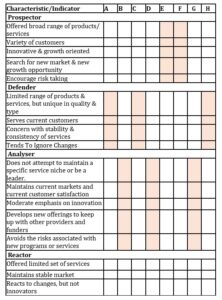
Based on Miles and Snow’s typology (1987), the findings revealed that school co-operative E and F can be classified as Prospectors. This is because both school co-operative offered a broad range of products and services and have a variety of customers not only from school teachers and students but also from outsiders searching for their products and services. School co-operative E stated that “Other than school necessity items, we also sell frozen foods, cookies and bumiputra product namely Faezah brand”. They also constantly seek new business opportunities by promoting their products and services and targeting different markets too. This is supported by the statement from school co-operative F that mentioned “We do provide convocation robe rental to customers who wish to hold a convocation session at our school. Thus, our customers were not limited school teacher and students, but also kindergartens and institutions’ students that held convocation events at our school”. Both school co-operatives were also concerned with the growth of the co-operatives as they keep finding ways to encourage risk taking for new ventures. The school co-operatives were also presented a good performance.
School co-operatives A, C and H are classified as Defenders. These school co-operatives provide a limited range of products and services, but unique in quality and type. They supply school necessities with unique logo for each school from exercise books, sport shirt and pants. Supported by school co-operative C that stated, “We only sell exercise book and school t-shirt that have a school logo as there has been some challenges towards the activities of co-operatives due to a circular issued by JPN”. All of the school co-operatives agreed that all students must use exercise books that have a school logo only. They also served current customers, who are the school teachers and students in each school. These school co-operatives are concerned with the stability & consistency of the products and services they offered. Their main strategy is to sell at affordable price to students. Stated by one of the school co-operatives, “We just offered low prices that market value where it will be affordable to the students as the school is at rural area”. All these three school co-operatives only focus on selling necessity items; as a result, they gain a small amount of profit, and they tend to ignore the changes.
School co-operatives B, D and G can be classified as Analyser. These co-operatives do not provide niche services, nor become a leader in the market. They provide extra services to maintain current markets and current customer satisfaction. As an example, school co-operative B mentioned that “We serves internal customers, which are students and teachers. In order to attract teachers to join co-operatives, they gave souvenirs upon joining. The co-operative also organizes a trip for students to boost the co-operative value as members”. These co-operatives do develop new offerings and try to keep up to date with others on the market, however, they are moderate for the changes. They offered photostat services, binding, received rental income for the space rented and one of the school co-operatives organized a school trip for students to interesting places. This is supported by the statement from school co-operative A that stated, “We do offer services related to hospitality by organizing a trip for interested co-operative members”. Then school co-operative D mentioned that “We have extra services to co-operative members by providing photostat services, binding and others”. While school co-operative G said that “We also offered a space rent for outsiders to provide photostat machine services to the students”. These co-operatives tend somehow to minimize risk associated with new businesses. These school co-operatives, play with the price of the product where they usually gave discount, reduces price, offer instalment for needed students and carried out a promotion for low turnover stock.
Miles and Snow’s (1978) posited organization classified as Prospectors, Analysers and Defenders is equally effective if properly implemented and will outperform Reactors. Japelus et al (2017) also have used Miles and Snow’s (1978) typology as it is the most appropriate to determine the strategy adopted by co-operatives. Hence, based on the data gathered, all eight school co-operatives can be categorized as Prospectors, Analysers and Defenders that have satisfactory performance. None of the co-operatives selected was categorized as Reactor. Hence, the findings showed that the school co-operative strategy identified was in line with Miles and Snow’s proposition and agreed with Japelus et al (2017). Further findings on the school co-operatives business strategies are presented in this study. The summary of school co-operatives’ business strategies adopted by the eight school co-operatives is presented in Table 4.
Table 4: The School Co-operatives Business Strategies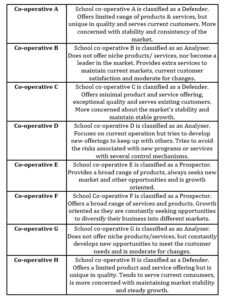
Accountability of School Co-operatives
Another objective of this research is to identify the indicators to measure the accountability of school co-operatives. This study applies the definition stated by Japelus et al (2017): “Accountability was defined as the achievement of accountability, through the achievement of both financial and non-financial performance of school co-operatives to their members.” The achievement of accountability through financial performance refers to the transparency where all school co-operatives disclosed financial information such as dividend, turnover, profit in the Annual Report of school co-operatives, and it must be evaluated regularly. The achievement of accountability through non-financial performance was based on how the school co- operatives managed the complaint and its response to co-operative members, active participation and other non-financial aspects were used by the school co-operatives. Prior study by Japelus et al (2017) have identified four (4) indicators to measure accountability level of co-operatives which are (i) transparency, (ii) evaluation, (iii) complaints and responsiveness, and (iv) participations. They found out that these indicators were applied indirectly in the co-operatives. Hence, this study employed Japelus et al’s (2017) which is the extension from Blagescu et al.’s (2005) Global Accountability Project Framework as a reference to measure accountability of co-operatives. The indicators used to determine the accountability of school co-operatives are listed in Table 5.
Table 5: The Detailed Analysis of Accountability Level in School Co-operatives
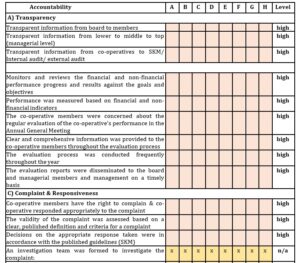
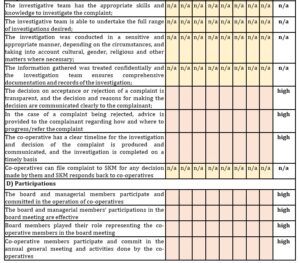
The findings revealed that all eight school co-operatives disclosed transparent information. School co-operative C stated that “Transparency is emphasized in our co-operative, as it is the duty of trust in the appointment as Co-operative Board Members”. School co-operative B also stated, “We disclosed everything to our members”. Same as the other school, they will disclose information in terms of finances, donation activities and other activities during the Annual General Meeting (AGM)”. School co-operative H also added “The committee members will report all information regarding finances, activities carried out by the co-operative to board.” Then, school co-operative G mentioned that “All school co-operatives are being monitored by SKM. All the activities carried out by the co-operative, the financial report, periodic meetings must be reported to SKM”. Hence, based on the data gathered, all eight school co-operatives disclosed transparent information at all stages from board to members, at managerial level, from school co-operatives to Suruhanjaya Koperasi Malaysia (SKM) or Internal Auditor.
Based on the data collected, all eight school co-operatives do acknowledge the importance of evaluating their performances. They will monitor and review financial and non-financial performance progress and results against goals and objectives. This is supported by the school co-operative B statement that “at each meeting the co-operative always refers back to the main objective of the activities whether achieve or not”. School co-operative D added, “The monitoring and review process, normally referred to the financial statement in term of profit or loss, the distribution of money for charity activities, whether they want to increase or decrease the amount or hold its first”.
Furthermore, the performance of school co-operatives is being measured based on financial and non-financial indicators too. School co-operative G stated that “The performance being measure based on non-financial in terms of the distribution of the student’s welfare. In terms of financial normally referred to the budget amount for certain development or activity”. The same goes to school co-operative B, “The targeted retails sales or revenue, tourism activities and contribution amount is determined in board meetings by referring to the previous performance of co-operatives as benchmark”. The members of school co-operatives were also concerned with the evaluation of performance and had been provided with a comprehensive report. Besides, all school co-operatives conducted an evaluation process regularly and are disseminated timely too. This is supported by the statement mentioned by school co-operative E, “The AGM is conducted once a year and board meeting of co-operative is conducted four times in a year”. Most of the school co-operatives will conduct an evaluation process at two to four times in a year. Overall, the evaluation of the school co-operatives performance is one of the appropriate indicators to determine the accountability of school co-operatives.
Complaint and responsiveness are another suitable indicator to measure accountability in school co-operatives. The members normally complain about any dissatisfaction in relation to the product or services offered by the school co-operatives. This research discovered that all school co-operatives received complaints as members had the right to complain and they will respond quickly to the complainant. Supported by statement from school co-operative E, “The co-operative members do have the right to complain if there is damage. The co-operative teacher in charge during that hour will take note of the complaint and take action for each complaint filed”. They added, “If there is a complaint and cannot be resolved directly, then the matters will be discussed in, the board meeting of co-operative for solution and improvement”. According to the statement, school co-operatives generally solved the issues based on the situation. If the complaint is straightforward then they will resolve it immediately. They also have their own guidelines on how to handle the complaint and respond to it. This is because all school co-operatives are subject to “Undang-Undang Kecil Koperasi” where the rules and regulation are all from SKM. None of the school co-operatives had a specific investigation team to handle complaints. In addition, all school co-operatives do react with facts according to the complaints. Any dissatisfaction with the response, they will consult the complainant directly. Next, all school co-operatives do not file any complaint to SKM. Instead SKM the one will advise on matters related to SKM procedure such as co-operative members, board appointment, training. This is supported by the statement made by one of the selected school co-operatives that said “If there is a problem, the school co-operative usually will refer to SKM”.
The last indicator that was used is participation. Participation is very important in every school co-operative. The board and managerial members participate effectively and committed in the operation of the co-operative. Supported by school co-operative G, “The board is committed to make sure all the activity run smoothly. They will do a post-mortem meeting, do evaluation and concise report whether that activity achieves the objective or not”. The board members played their role representing the members in the co-operative. School co-operative C confirmed that “The board members will respond directly towards any suggestion by the co-operative members during the AGM”. Not to mention, the school co-operative members themselves participate, committed to join any activities carried out by the school co-operatives too. School co-operative G said that “During the AGM, all co-operative members will join the meeting and there will be a two-way communication”. Thus, the findings revealed that all the school co-operatives have good participation from the board, managers and members.
Consequently, based on the findings above, all eight co-operatives have indirectly applied the suggested indicators by Japelus et al (2017) and Blagescu et al. (2005). Hence, the four indicators (i) transparency, (ii) evaluation, (iii) complaint and responsiveness, and (iv) participations were suitable to determine the measurement for accountability of co-operatives and it is parallel to the definition of accountability in this study.
Strategy and Accountability of School Co-operatives
Another research objective of this study is to explore the connection between the strategies and accountability of school co-operatives. Based on the data gathered, this study was able to determine the strategy pursued by the co-operatives with reference to the Miles and Snow’s (1978) typology and their accountability based on Japelus et al’s (2017). As a result, school co-operatives E and F can be categorized as Prospectors; school co-operatives A, C and H are classified as Defenders; and school co-operatives B, D and G can be classified as Analyzers. None of the samples selected in this study can be classed as Reactor. Based on the information gathered too, the indicators measure the accountability of co-operatives could be determined. The findings revealed that all eight school co-operatives have high accountability level as they complied with the suggested indicators which are: (i) transparency, (ii) evaluation, (iii) complaint and responsiveness and (iv) participations.
Hence, based on the findings, it can be concluded that school co-operatives which have been classified as Prospectors, Analysers and Defenders have high accountability level. School co-operatives E and F have been classified as Prospectors and have high accountability level. Similar to school co-operatives A, C and H which are classified as Defenders and, have high accountability level, and school co-operatives B, D and G which are classified as Analyzers, have high accountability level. This is in parallel with the first, second and third research propositions as this study anticipate that co-operatives classified as Prospectors, Analysers and Defenders will have high accountability level. None of the co-operatives selected were categorized as Reactor. Therefore, there is a connection between strategy and accountability level in co-operatives.
School co-operatives classified as Prospectors provide a broad range of products, constantly seek new markets and other opportunities to enhance the co-operative performance. In short, they are growth oriented. Hence, in order to achieve the goals, they should practice high accountability level. This supports the findings that school co-operatives E and F that can be classified as Prospectors have high accountability level. Following that, school co-operatives classified as Defenders have a minimal products and services’s offering, remarkable quality and serve existing customers. They are more concerned with maintaining market stability and steady growth. With this optimistic strategy, they must have practiced high level of accountability to successfully reach their objectives. This supports the findings that school co-operatives A, C and H that can be classified as Defenders have high accountability level.
Subsequently, school co-operatives which were classified as Analysers do not offer niche products or services, but frequently develops new opportunities to meet the customer needs. They are moderate for changes. With this optimistic strategy too, they must have practiced high level of accountability to successfully reach their goals. This supported the findings where co-operatives B, D and G which have been categorized as Analysers showed high level of accountability. Hence, this study found that there is a connection between strategy and the accountability of school co-operatives. The detailed connection between strategy and accountability is presented in Table 6.
Table 6: The details association between Strategy and Accountability
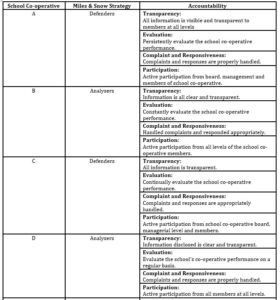
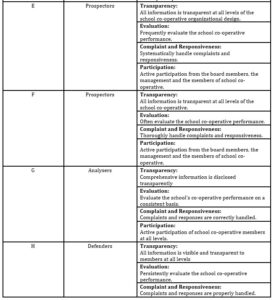
Based on the discussion on the analysis above, The following section will discuss the framework on strategy and accountability level for School Co-Operatives derived from the discussion analysis above.
Framework on Strategy and Accountability Level for School Co-Operatives
The framework shows that there is an association between strategy and accountability level of school co-operatives regardless the business activities handled by them. There are four strategy typologies used for this study that classified as Prospectors, Defenders, Analysers and Reactors. Based on the analysis section, the strategy typologies used are only pertinent for Prospectors, Defenders and Analysers for School Co-operatives, none of the school co-operatives that were selected fell under the category of Reactors. This might be due to the types of business activities involved by each of the School Co-operatives preferred. All eight school’s co-operatives have high accountability level that contains transparency, evaluation of performance, complaints and responsiveness and participations. Hence, this framework demonstrates that strategy is associated with accountability level. Figure 2 represents the framework on strategy and accountability level for school co-operatives.
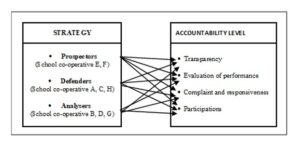
Figure 2: The framework on Strategy and Accountability level for School Co-operatives
(Original sources)
Conclusion
As a conclusion, this study provides the insightful scenario about the strategy and accountability in school co-operatives. The study proved there has been an association between strategy and accountability level for school co-operatives in the Johor state (Segamat region) of Malaysia. The strategy and accountability derived from this study are vital criteria used for school co-operatives. They can be used as the basis to develop guidelines for appropriate strategies and to measure the accountability for school co-operatives. In addition, further study can be explored on the types of business activities involved with the association of strategy and accountability. This study also contributes to the body of knowledge of the indicators to measure accountability for school co-operatives and divulged that transparency, evaluation, complaints and responsiveness, and participation of members are four indicators of accountability applied by school co-operatives. This study used qualitative approach and it can be extended to use a quantitative approach to support the research findings. Therefore, this study can assist school co-operatives to strategize their business activities with an appropriate accountability guideline provided. The extended study can be conducted in other states in Malaysia in order to get more understanding of the strategy and accountability practices from other school co-operatives.
Acknowledgement
Fund for this study is supported by Research Grant GBest phase 2/2020, Universiti Teknologi MARA Johor branch and the authors are thankful to the university for the funding and support.
References
- Blagescu, M., Casas, L. D. Las and Lloyd, R. (2005) ‘Pathways to Accountability: A Short Guide to The Gap Framework’ London: One World Trust.
- Boomsma, R. and O’Dwyer, B. (2019), ‘Constituting the Governable NGO: The Correlation Between Conduct and Counter-Conduct in The Evolution of Funder-NGO Accountability relations,’ Accounting, Organizations and Society, 72, 1-20.
- Brown, W.A. and Iverson, J.O. (2004), “Exploring strategy and board structure in nonprofit organizations,’ Nonprofit and Voluntary Sector, quarterly 33(3), 377-400.
- Co-operative Societies Act 1993 (Act 502) and Regulations Selangor (2008). International Law Book Services.
- Co-operatives Statistics Malaysia Interim (2021), Suruhanjaya Koperasi Malaysia, [Online], [Retrieved April 5, 2022], https://www.skm.gov.my/images/images/Statistik-Gerakan-Koperasi/Statistik-Interim/Statistic-Interim-2021/ringkasanperangkaanjun2021.pdf
- Dasar Keusahawanan Nasional 2030 (2019), Kementerian Pembangunan Keusahawan, [Online], [Retrieved July 22, 2020], https://www.pmo.gov.my/wp-content/uploads/2019/08/Dasar-Keusahawanan-Nasional-DKN-2030_x.pdf
- Doty, D.H., Glick, W.H. and Huber, G.P., (1993). ‘Fit, equifinality, and organizational effectiveness: A test of two configurational theories.’ Academy of Management journal, 36(6), pp.1196-1250.
- Elee, E.G. (2021), ‘Formation of Cooperative Societies in Secondary School for Improved Staff Welfare: A Case Study of Selected Secondary Schools in Awka South. Unizik Journal Of Educational Research And Policy Studies, 6, 231-247.
- Ewang, S. H., Abidin, J. H. O. Z., and Rustam, M. A. (2020), ‘Motivation Role of the Operational Manager’s Opportunities to School Business Performance,’ International Journal of Academic Research in Business and Social Sciences, 10(9), 288-299.
- Gazzalo, P., Amelio, S., Papagiannis, F., and Michaelides, Z. (2021), ‘Sustainability reporting practices and their social impact to NGO funding in Italy,’ Critical Perspectives on Accounting, 79, 102085.
- Gijselinckx, C. (2009) ‘Co-operative Stakeholders. Who Counts in Co-operatives, and How?,’ Social and Co-operative Entrepreneurship. 1-36.
- Hitt, M. A., Ireland, R. D., and Hoskisson, R. E. (2001) Strategic management: Concepts and cases: Competitiveness and globalization, Cengage Learning.
- Ismail, A. M. (2005) Jati diri koperasi, Utusan Publications & Distributors Sdn. Bhd., Kuala Lumpur.
- Ismail, A. M. (2005) Kepimpinan Koperasi: Memimpin dan Dipimpin, Utusan Publications & Distributors Sdn. Bhd.,Kuala Lumpur.
- International Co‐operative Alliance (1995), ICA Statement of Co‐operative Identity, Adopted ICA Centennial Congress, Manchester, ICA, Geneva. [Online], [Retrieved July 22, 2020], https://www.ica.coop/en/cooperatives/cooperative-identity/
- Japelus, N. E., Hamzah, N. and Saleh, N. M. (2017). ‘The Association Between Strategy and Accountability Level of Co-operatives,’ Amity Journal of Corporate Governance, 1(2), 1-21.
- Juliana, M. Y. (2016) ‘Koperasi sekolah: Menelusuri matlamat penubuhannya,’ Dimensi Koop. 38–46.
- Koperasi Sekolah Mampu Peroleh 1 Juta, (2019), Harian Metro, [Online], [Retrieved July 14, 2020] https://www.hmetro.com.my/mutakhir/2019/02/424576/6-koperasi-sekolah-mampu-peroleh-rm1-juta
- Koperasi sekolah terus berdaya saing, (2019), Sinar Harian, [Online], [Retrieved July 14, 2020], https://www.sinarharian.com.my/article/42211/BERITA/Nasional/Mahu-koperasi-sekolah-terus-berdaya-saing
- Lassou, P.J.C. (2017), ‘State of government accounting in Ghana and Benin: A “tentative” account.’ Journal of Accounting in Emerging Economies, 7(4), 486–506.
- Majid, N. A., Zainol, F. A., Daud, W. N. W., and Afthanorhan. A. (2019), ‘Cooperative Entrepreneurship in Malaysian Secondary Schools,’ A Review of Current Practices, 5(3), 812-818.
- Malta, M. C., Meira, D. A., Bandeira, A. M., and Santos, M. (2019),’ ‘A Domain Model for Transparency in Portuguese Cooperatives: The Governance Structure and Accountability Dimensions,’ In Modernization and Accountability in the Social Economy Sector, 43-56.
- Miles, M.B, Huberman, A.M. and Saldaña, J. (2014) Qualitative Data Analysis: A Methods Sourcebook. 3rd Edition. Saga Publications
- Miles, R and Snow C. (1978), ‘Organizational Strategy, Structure, and Process, New York: McGraw-Hill.
- Moore, M. H. (2000), ‘Managing for value: Organizational strategy in for-profit, nonprofit, and governmental organizations.,’ Nonprofit and voluntary sector quarterly, 29(1), 183-204.
- Othman, R., Embi, R., Aris, N. A., Arif, S. M. M., Choo, H. C. and Ismail, N. (2016), ‘Board Governance and Performance: An Exploratory Study of Malaysian Cooperative Organizations,’ Journal of Southeast Asian Research.
- Pozen, D.E., (2020), ‘Seeing transparency more clearly.’ Public administration review, 80(2), pp.326-331.
- Shabri, S. M., Saad, R. A. and Bakar, A. A. (2017), ‘A Research Model of Cooperative Governance Performance in Malaysia,’ Journal of Humanities, Language, Culture and Business, 1(3), 131-144
- Tumpu Pembangunan Koperasi Sekolah, Realisasi Negara Keusahawanan 2030, (2019), Sinar Harian, [Online], [Retrieved July 14, 2020], https://www.sinarharian.com.my/article/39880/BERITA/Nasional/Tumpu-pembangunan-koperasi-sekolah-realisasi-negara-keusahawanan-2030
- Yasmin, S., Ghafran, C., and Haniffa, R. (2018), ‘Exploring de-facto accountability regimes in Muslim NGOs,’ In Accounting Forum. 42(3), 235-247.
- Yin, R.K. (2014) Case Study Researh: Design and Methods, 5th Edition. Saga Publications, Inc.
- Zahra, S.A. and Pearce, J.A., (1990). ‘Research evidence on the Miles-Snow typology.’ Journal of management, 16(4), pp.751-768.
- Zimnoch, K., (2018).The Role of Student Cooperatives in Education in Poland in the 21st Century. In Proceedings of the International Scientific Conference “Rural Environment. Education. Personality (REEP)(No. 11)
- S. and Susanti. S. (2017), ‘School Cooperatives Management of Business Vocational High School,’ Advances in Economics, Business and Management, 45(2), 92-95.












